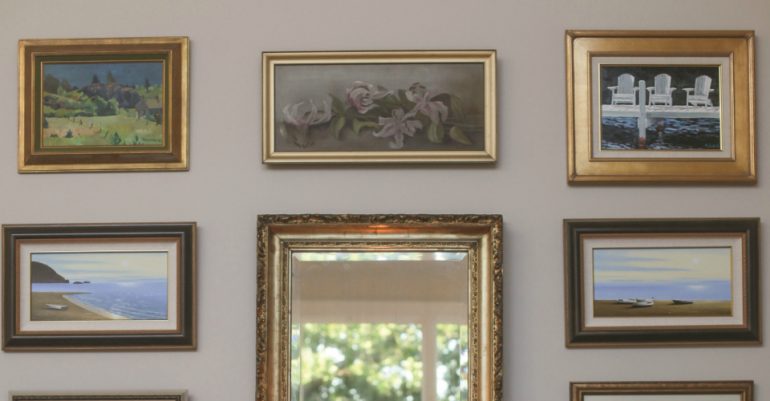By Katie Vaughn | Photography by Shanna Wolf
START WITH THE ART
Let’s be clear: There’s no such thing as “right” or “good” art—just art that speaks to you. If you’re choosing new art, start by getting a feel for what you like. When a work catches your eye, try to determine why. Is it the colors, the subject matter or the mood? A sense of calmness or an exciting dynamism? And is it a portrait, landscape, still life or abstract work? These can all be clues to identifying your aesthetic.
When it’s time to shop, keep both your stylistic preferences and practical needs in mind, suggests Tory Folliard, director of Tory Folliard Gallery in Milwaukee.
“Once I have a better idea of their taste, the size and a general idea of the amount they would like to spend, I am able to provide [clients] with options,” he says. “Along the way, there is an education process—providing information about the artists they are considering and the works themselves.”
EXPAND YOUR OPTIONS
Paintings, drawings, prints, photographs and mixed-media works on paper and canvas are all fantastic art options that look wonderful on a wall. But what else might you frame and hang? Pretty pieces of wallpaper or fabric, old maps or mementos and items of clothing with sentimental value could have new life as art.
“All artwork is worthy of conservation framing—a child’s artwork, a hard-earned diploma, family photographs, even a signed concert poster,” says Gary Milward of Gary’s Art & Frame in Middleton.
And perhaps art you already own just needs to be reframed or placed somewhere new to shine.
“Many of my clients have collections of stunning art pieces,” says Lisa Mohindroo of Milwaukee-based Mohindroo Interiors, “but their beauty needs to be brought to its fullest by displaying them in ideal locations of the home.”
CONSIDER YOUR DÉCOR
Once you’ve found art you love, how do you make sure it works with the décor in your home?
“Really, the only rule of thumb that I follow is to make sure your art doesn’t match your interior,” says Barry Avery, owner of Fontaine Home in Madison. “I tell clients that we don’t want to be matchy-matchy—we can do better than that.”
So if a home is decorated in saturated jewel tones, Avery wouldn’t place a similarly hued painting in the space; he’d opt for something lighter for contrast. It’s the same with design styles: The magic comes in mixing things up.
“If someone has an extremely modern home, I might have them try a gilded frame with a traditional oil painting,” Avery says. “If they’ve got a more traditional environment going on, bring that more contemporary piece in.”
Ultimately, choosing art you love— not what matches your sofa—makes good financial sense. “Fabrics, styles and color trends come and go,” says Folliard, “but hopefully, if they choose wisely, the art will be with them for the long haul.”
THINK INSIDE THE BOX
These days, the options for showcasing art are nearly limitless.
“Honestly, it’s a personal preference,” says Jamie Jorndt, an artist and volunteer at Gallery 223 in Lake Geneva. “Some like a raw canvas, some like works framed. And I’ve noticed more framing of canvases lately.”
The only constant considerations when framing, says Milward, are related to quality and protection. Choose conservation-quality UV-filtering glass, high-quality mats and proper mounting techniques, he says, and never put photographs in direct contact with glass or glue down original art.
As for design, simple, clean looks are on trend, Milward says, pointing to thin floater frames that surround a canvas and large white or neutral mats paired with simple black moulding. For those looking for a jolt of color, Milward suggests Prisma frames. Made from clear Lucite, they can be customized in various colors, patterns, textures and shapes to suit the art they will hold.
SEE THE LIGHT
Think about lighting to ensure your masterpiece is both visible and protected. Talk to your framer or art dealer if a piece will be hung in direct sunlight to make sure it won’t suffer from fading or other damage.
But don’t leave your art in the dark! “More and more clients are understanding the need for picture lighting,” says Avery. Sure, recessed ceiling lights can do the job, but many homeowners are opting for lights placed above that specially bathe art in soft light. And it’s not just traditional brass fixtures anymore—choose from classic lamps to sleek bars in a wide range of finishes.
LEVERAGE YOUR LOCATION
Take stock of your space long before picking up a hammer or drill. “Every room is different— some rooms have high ceilings, others may feature many windows with just a narrow wall space to work with,” says Mohindroo. Take a step back and keep scale in mind.
For instance, you may know you want to hang a painting in your dining room, but a work that’s on the smaller side would look teeny on an expansive wall. A large-scale canvas, though? Hello, bold statement!
You could also opt for a triptych or a tight grouping of works that reads like a unit, suggests Avery. A single frame style would enhance the cohesiveness. Or maybe a gallery-wall treatment of several different-sized pieces would best fill the space. Go with whatever feels right, suggests Jorndt. “You’re basically looking for balance.”
A gallery wall looks especially great in long hallways and offices where you might want to feature a variety of artwork. You can go with matching frames and an orderly arrangement for a calmer, tidier feel, or vary materials, colors and sizes for more personality.
And whether your art’s hanging with a group or flying solo, think beyond the basics of placement. Kitchens, bathrooms and bookshelves can all be stellar—and eye-catching— spots to have an artistic moment.
“Any space in your home that could use a little livening up should be fair game,” says Mohindroo.





